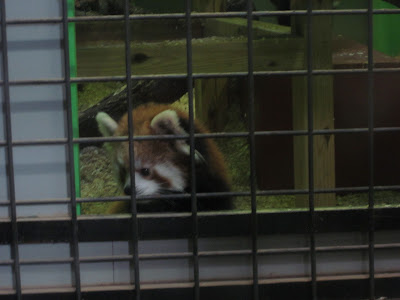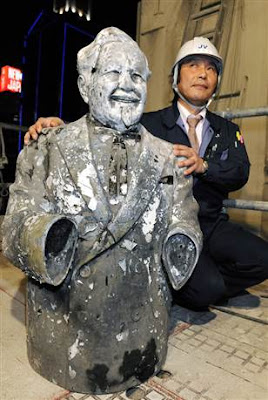One of the more popular places to go on the weekends is the laid back Yoyogi Kōen (代々木公園). Kōen (公園) is park in Japanese and Yoyogi Kōen is one of the largest of Tokyo's. Its large green space is within 15 minutes of our place and makes the perfect place to unwind from the hustle and bustle of Tokyo. While next to the important shrine of Meiji Jingū, this park did much more to shape the area around it culturally. Its unique history, both before and after the park's creation explains how the park could have so much impact on its surrounding areas.
Yoyogi Kōen is actually the site of Japan's first powered flight. On December 19th, 1910, Yoshitoshi Tokugawa flew the first flight from what is now Yoyogi Park. There is still a first flight monument in the park, but it is fairly secluded and I doubt many people would know Japan's first flight had occurred within the park grounds. It's certainly not as famous as the area of Kitty Hawk, which had the first powered flight 7 years prior. Yoyogi Park would be a military parade ground during this time to until the end of World War II.
After World War II, this area became Washington Heights, the residences for American officers during the occupation following the war. After their departure in 1952 with the end of the occupation, the area of Yoygi Park was now a wide open space. This space would prove useful for Japan's upcoming Olympics.
Japan was originally supposed to host the Olympics in 1940. It would have hosted the summer Olympics in Tokyo and the winter Olympics in Sapporo, but obviously World War II had cancelled the event. (In case you're wondering, the summer and winter Olympics were held in the same year until 1994 when they moved the winter Olympics up two years to separate the two.) However, Japan would win the bid for the 1964 Olympics in Tokyo, making it the first country in Asia to host the Olympics. This event not only had a major impact for Japan, but caused a lot of dramatic changes for Tokyo. The Olympics came at and also sparked a big moment for Japan. Japan's 'Economic Miracle' started around this time, and Japan would begin another phase of modernization and globalization around this time. The 1964 Olympics not only reflected and symbolized these changes, but also spurred them further. The first Shinkansen (新幹線) or 'Bullet Trains' were built for the Olympics to provide quick connections between Tokyo and Osaka and Kyoto. Now, they are a common and popular form of travel in Japan and one of the symbols of Japan's advanced technology. In Tokyo, the Olympics caused the end of the trolley lines, as all of them were ripped out except for the Arakawa Tram Line, still existing today, because they were seen as not being modern. It also shaped popular destinations around Tokyo as amenities were added. One example being the chairlift on Mt. Takao, a popular destination during the Olympics and today. The site of Yoyogi Kōen and its surrounding area would see big changes too.
 |
| Mt. Takao's chairlifts, still a popular attraction today. |
This large free space in the middle of Tokyo made the perfect spot for the Olympic Village, and tiny houses were setup throughout. Near the Olympic Village, the Yoyogi National Gymnasium was built by Kenzo Tange for swimming, diving and basketball during the Olympics. It is still used as a National Stadium today, along with other sporting events and music concerts, and has had a lasting architectural impact. Yoyogi Kōen still has one of the Olympic Village houses left, preserved for its history.
 |
| Yoyogi National Gymnasium. |
The Olympics left a lasting cultural impression on Japan and was the direct cause of the new culture that has become the essence of the surrounding area. The Olympics brought a huge variety of global culture into Japan which has drawn interest from Japanese people ever since. The epicenter of this cultural exchange was at the Olympic Village, which has created a culture hub in the area reflecting the international flair which tastes were first developed then. The most famous of these is Harakjuku, long known as the famous center of youth culture in Tokyo. Nearby Omotesando has a more grown-up international fare and even Yoyogi Park still has many music performances and clubs going to the park to play and dance music from all over the world, even drawing tourists and people to go just to watch them. While there's very little directly remaining from the Olympics, the whole culture of the park and surrounding area still has the culture of internationalism brought from the Olympics. This can also be seen in the festivals held at the park. These festivals focus on the food, famous items, music and culture of different locations, almost all of them outside of Japan. Going to these and experiencing a different country every week is one of the highlights for me during the late summer and early fall when they happen. I will write more about these festivals in the future when I go and experience them.
For most people, the Olympic memory and legacy has been forgotten, even by those still participating in its legacy. These days, Yoyogi Kōen functions as just a park and a popular escape from the city since its beginning in 1967. The park itself is great and has a lot to offer and a lot of things to do and see.
 |
| A map of the park. Meiji Jingū to the top left, Yoyogi National Stadium to the top right. |
The park has a lot of different things to do. Around the central area are paths for walking, running and bicycle riding. There's even a cycling center, where people can rent bicycles in the northwest section of the park. The park also has a variety of gardens, including a rose garden, the Sample Garden, which is a garden that has the trees and plants brought by other countries and planted here during the Olympics and a bird sanctuary. The most popular part of the park is the wide open central area where people have picnics, play sports, games and musical instruments which are usually impossible to play in Tokyo, except for the park areas and just relax. The park also has a dog park, which is one of the few places where dogs can be off their leashes and is separated by size of the dog into a few areas.
 |
| Some of the big trees in the center area. Only the tallest of Tokyo's buildings can be seen inside the park. |
 |
| The pond and fountains in the central area. We normally try and find an empty spot around here to spend time at. |
 |
| During the fall, one of the few spots with leaves covering the ground. |
 |
| The main avenue towards the pond. To the right is the rose garden. I took this picture on the walkway bridge that connects the main area of the park with the athletic fields and the National Stadium. |
 |
| The pillars on the walkways in the park are covered in interesting graffiti, making interesting backdrops to the dancing and performance groups in the park. |
When we go to Yoyogi Park, it's either for the festivals or to relax. We often bring bento (弁当), or boxed lunch and set up a picnic under the tall trees there. Then we'll either relax or find an empty spot (a bit hard to do sometimes as there are so many other people) to play some type of game or sport. Sometimes, we ride our bicycles around the bike path and around the park. Whatever we end up doing, every time is a great time to get away from the city and be surrounded by green and trees for as far as you can see.
References:
1. 野牛重兵衛, "オリンピック記念宿舎," 脱藩浪士の日々.
http://jyube.blog56.fc2.com/blog-entry-840.html.






























































